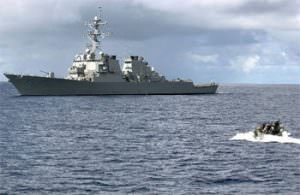Trump Nuclear Doctrine Calls for Tougher Stance on Russia
The administration says the Kremlin must be persuaded it would face "unacceptably dire costs" if it were to threaten even a limited nuclear attack in Europe.WASHINGTON — The Trump administration on Friday announced it will continue much of the Obama administration’s nuclear weapons policy, but take a more aggressive stance toward Russia. It said Russia must be persuaded it would face “unacceptably dire costs” if it were to threaten even limited nuclear attack in Europe.
The sweeping review of U.S. nuclear policy does not call for any net increase in strategic nuclear weapons, a position that stands in contrast to President Donald Trump’s statement, in a tweet shortly before he took office, that the U.S. “must greatly strengthen and expand its nuclear capability until such time as the world comes to its senses regarding nukes.” In his State of the Union address Tuesday, he made no mention of expansion, though he said the arsenal must deter acts of aggression.
A 74-page report summarizing the review’s findings calls North Korea a “clear and grave threat” to the U.S. and its allies. It asserts that any North Korean nuclear attack against the U.S. or its allies will result in “the end of that regime.”
“There is no scenario in which the Kim regime could employ nuclear weapons and survive,” it says.
The Pentagon-led review of the U.S. nuclear arsenal and the policies that govern it was ordered by Trump a year ago. Known officially as a nuclear posture review, it is customarily done at the outset of a new administration.
The Trump administration concluded that the U.S. should largely follow its predecessor’s blueprint for modernizing the nuclear arsenal, including new bomber aircraft, submarines and land-based missiles. It also endorsed adhering to existing arms control agreements, including the New START treaty that limits the United States and Russia each to 1,550 strategic nuclear warheads on a maximum of 700 deployed launchers.
The treaty, negotiated under President Barack Obama, entered into force on Feb. 5, 2011, and its weapons limits must be met by Monday. The U.S. says it has been in compliance with the limits since August and it expects the Russians to comply by Monday’s deadline. As of Sept. 1, the last date for which official figures are available, Russia was below the launcher limit but slightly above the warhead limit, at 1,561.
“Moscow has repeatedly stated its intention to meet those limits on time, and we have no reason to believe that that won’t be the case,” State Department spokeswoman Heather Nauert said Thursday.
The Pentagon’s nuclear review concluded that while arms control can advance American interests, “further progress is difficult to envision,” in light of what the U.S. considers Russia’s aggression in Ukraine and violations of existing arms deals.
The Trump nuclear doctrine breaks with Obama’s in ending his push to reduce the role of nuclear weapons in U.S. defense policy. Like Obama, Trump would consider using nuclear weapons only in “extreme circumstances,” while maintaining a degree of ambiguity about what that means. But Trump sees a fuller deterrent role for these weapons, as reflected in the plan to develop new capabilities to counter Russia in Europe.
The administration’s view is that Russian policies and actions are fraught with potential for miscalculation leading to an uncontrolled escalation of conflict in Europe. It specifically points to a Russian doctrine known as “escalate to de-escalate,” in which Moscow would use or threaten to use smaller-yield nuclear weapons in a limited, conventional conflict in Europe in the belief that doing so would compel the U.S. and NATO to back down.
“Recent Russian statements on this evolving nuclear weapons doctrine appear to lower the threshold for Moscow’s first-use of nuclear weapons,” the review said.
The administration proposes a two-step solution.
First, it would modify “a small number” of existing long-range ballistic missiles carried by Trident strategic submarines to fit them with smaller-yield nuclear warheads.
Second, “in the longer term,” it would develop a nuclear-armed sea-launched cruise missile — re-establishing a weapon that existed during the Cold War but was retired in 2011 by the Obama administration.
Robert Soofer, a senior nuclear policy official at the Pentagon who helped direct the policy review, said Moscow is likely to push back on the U.S. plan for fielding those two additional weapons.
“I’m sure they won’t respond well,” Soofer said Thursday.
The press secretary at the Russian Embassy in Washington, Nikolay Lakhonin, said he would not comment until the review had been made public.
Asked whether the two new nuclear weapons are needed to deter Russia, Defense Secretary Jim Mattis said Friday, “We are deterring nations that have spoken about using nuclear weapons.”
The Associated Press reported last month on key elements of the U.S. nuclear review, based on a draft version of the document, including its endorsement of the Obama administration plan for fully modernizing the nuclear arsenal by building a new strategic bomber, a new land-based intercontinental ballistic missile and a new fleet of nuclear-armed ballistic missile submarines. It also endorsed modernizing the network of communications systems, warning satellites and radars, and command centers that are used to control the nuclear arsenal.
—
Associated Press writer Josh Lederman contributed to this report.
Your support is crucial…With an uncertain future and a new administration casting doubt on press freedoms, the danger is clear: The truth is at risk.
Now is the time to give. Your tax-deductible support allows us to dig deeper, delivering fearless investigative reporting and analysis that exposes what’s really happening — without compromise.
Stand with our courageous journalists. Donate today to protect a free press, uphold democracy and unearth untold stories.








You need to be a supporter to comment.
There are currently no responses to this article.
Be the first to respond.